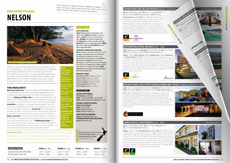New Zealand’s breathtaking panorama of lakes, forest, coastline and snow-capped mountains adds an unforgettable dimension to outdoor activities of every description.
Water Sports
Living in an island nation means that most New Zealanders are never very far from the coast and, as a result, water sports are extremely popular. Visitors can view the landscape from the deck of a yacht or motor launch, indulge in a dinner cruise or combine boating with fishing, diving or whale watching. Options are available throughout the country, from island-hopping in the subtropical Bay of Islands to an Auckland Harbour boat tour or cruising the fiords in Fiordland. Get even closer to the water in a kayak or canoe – guided expeditions are available to introduce visitors to New Zealand’s unique landscape and wildlife. High-powered jet boats are the perfect way to explore the country’s alpine rivers (jet boats were actually invented here for exactly that purpose), while river rafting is always popular with thrill seekers. A unique alternative to white-water rafting is black-water rafting – on an underground river! Other popular water activities include surfing, windsurfing, kite-surfing and water-skiing.
Diving
New Zealand’s geographical location makes it a meeting point for currents from the Antarctic and the tropics, which results in a remarkable diversity of species. This fact, combined with clear water and a mild climate, ensures that New Zealand is a popular dive location. The Poor Knights Islands Marine Reserve off Northland is renowned for its remarkable mix of species, many found nowhere else in New Zealand. In the Cavalli Islands, the Rainbow Warrior, a ship belonging to the Greenpeace fleet, has been used as an artificial reef habitat. In the South Island, the Marlborough Sounds offer a great range of dives and Kaikoura is also popular. Although the waters are cold, Fiordland is the place to see the world’s largest population of black coral trees, some up to 200 years old. For beginner divers, instruction and certification programmes are widely available, while experienced divers should bring their Diver’s Certification Card with them. See www.divenewzealand.com for more information.
Golf
Golf is a popular pastime in New Zealand and there are more than 400 crowd-free golf courses where visitors can play year-round – more per capita than any other country! New Zealand golfing is relatively inexpensive, particularly at some of the smaller country courses. Breathtaking international courses like Kauri Cliffs in Northland, Gulf Harbour Country Club north of Auckland, Cape Kidnappers in Hawke’s Bay, Clearwater Resort in Christchurch, Terrace Downs in Canterbury and Millbrook Resort in Queenstown are not cheap, but playing them is guaranteed to be unforgettable. On the other hand, there is an excellent selection of inexpensive golf courses scattered the length of the country. They may not have the most luxurious of facilities, but the scenery may well be spectacular, the game challenging and the green fees great value. To find out more about golfing in New Zealand, see www.nzga.co.nz for an interactive map of golf courses by region. Visit www.bestofgolfnewzealand.com to find out about premium golfing.
Flightseeing
Flightseeing can offer a very different view of New Zealand, whether visitors are flying over an active offshore volcano or whale-watching off the coast of Kaikoura. Fiordland is a great region for taking a scenic flight – towering peaks take on new dimensions from the air – but opportunities for flightseeing in helicopters or fixed-wing planes are available all over the country. For a peaceful variation, visitors can float effortlessly over the landscape in a glider. Places such as Omarama in the Mackenzie Country are well known for their optimal gliding conditions. Some clubs offer the opportunity to fly in a two-seater glider with a qualified instructor. Another tranquil option is a scenic flight in a hot air balloon. The skies above New Zealand are also the setting for adventure! Paragliding is a combination of hang-gliding and parachuting. Those new to the sport can take a tandem flight. And for the biggest adrenaline rush of all, you can’t beat skydiving!
Fishing & hunting
New Zealand offers an excellent range of fishing and hunting opportunities against a backdrop of great scenery. For the ultimate thrill, try big game fishing in the Bay of Islands – Striped Marlin grow unusually large in these waters, averaging around 100 kg – and the region has been world-famous as a game fishing destination since the 1920s. For a more relaxing experience, opportunities to fish for trophy-sized Brown and Rainbow trout are available throughout the country: try Rotorua, Taupo, Canterbury and Southland. Salmon fishing is also on offer in Canterbury and on the West Coast. A licence is required for fishing, and regulations govern quantities and minimum catch sizes. See www.fishandgame.org.nz for detailed information.
New Zealand also offers some of the world’s finest waterfowl and trophy hunting. New Zealand’s nineteenth century European settlers brought with them species of animals that were familiar in their homeland. Introduced into a fertile, temperate habitat with no natural predators, they thrived, often growing to larger sizes than they did in their original home. Big game species in New Zealand now include Wapiti, Red Deer, Sika Deer, Rusa Deer, Sambar Deer, Whitetail Deer, Fallow Deer, Himalayan Thar, Austrian Chamois, Goat, Wild Pig and Wild Bull.
Hunting is encouraged in New Zealand to control the numbers of these introduced species and preserve native wildlife, but permits are required for those wishing to hunt on public conservation land and all hunters are required to carry a licence (see www.fishandgame.org.nz for information).
In all cases, a professional guide will provide the best local knowledge and information, arrange permits if necessary and ensure the safety of your clients in an environment that can be unpredictable. For more information on fishing and hunting, see www.fishnhunt.co.nz or www.fishandgame.org.nz.




 For information about advertising with us email
For information about advertising with us email